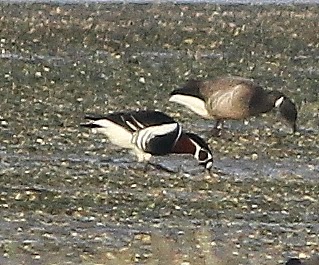For those who haven't come across the term WeBS before, it is the Wetland Bird Survey, which is a monthly winter count of waders & waterbirds in the UK. We have a coordinated count across the whole of the Poole Harbour on the low tide as it results in the highest counts. I think many parts of the UK carry out their WeBS counts on the high tide. However, in Poole Harbour we count on the low tide, as research by Nick Hopper a few years ago as part of the field studies for the Sound Approach Catching the Bug book by local birders, Mark Constantine & Nick Hopper, confirmed that counts are consistently higher on the low tides. On the high tides, a number of the duck & wader species disappear into the salt marsh to roost, making counting very difficult. Also sadly, disturbance is also likely to be higher on the high tides, as there are still a number of individuals locally who seem to think it's OK to kill wildfowl & this is more likely to happen on high tides.
Today, was the last winter count for Poole Harbour & while I was carrying out my sector on private land, I had a call from Kevin Lane on the adjacent section that he had just found a Red-breasted Goose in with a party of Brents. This had been reported a few days earlier flying out of the Middlebere channel, but there have been no further sightings. I looked a few days ago, but didn't find any Brents in the area I checked. Fortunately, I have permission to count in Kevin's sector & so joined him once my count was finished. Unfortunately, both Kevin & my sectors do not have any public rights of way. But there is a reasonable chance the Red-breasted Goose will reappear at Middlebere or be visible from the Middlebere channel side of the RSPB Arne reserve.
Today, was the last winter count for Poole Harbour & while I was carrying out my sector on private land, I had a call from Kevin Lane on the adjacent section that he had just found a Red-breasted Goose in with a party of Brents. This had been reported a few days earlier flying out of the Middlebere channel, but there have been no further sightings. I looked a few days ago, but didn't find any Brents in the area I checked. Fortunately, I have permission to count in Kevin's sector & so joined him once my count was finished. Unfortunately, both Kevin & my sectors do not have any public rights of way. But there is a reasonable chance the Red-breasted Goose will reappear at Middlebere or be visible from the Middlebere channel side of the RSPB Arne reserve.
Red-breasted Goose: Adult with Brent Geese. Unfortunately, it wasn't very close
Red-breasted Goose: Adult. Note, no rings on the legs
Red-breasted Goose: Adult. Adults have two clear white wingbars & sometimes a very faint third wingbar. Juveniles have several less clear cut, wingbars. Additionally, Juveniles have a duller, smaller face patch
Red-breasted Goose: Adult. About the best view of the third faint wingbar



